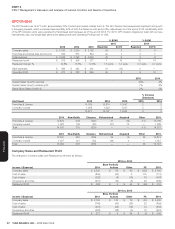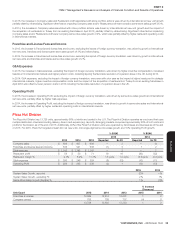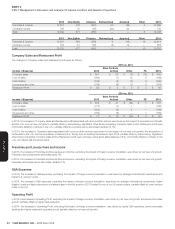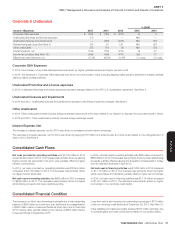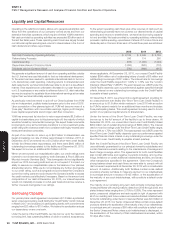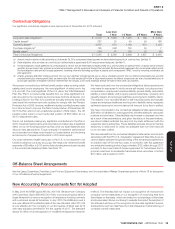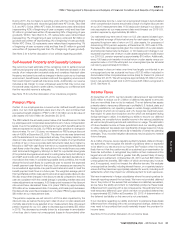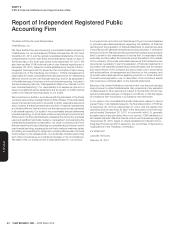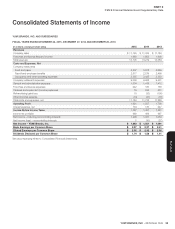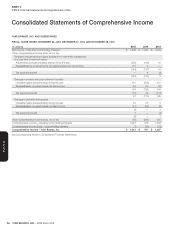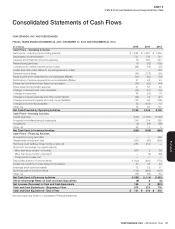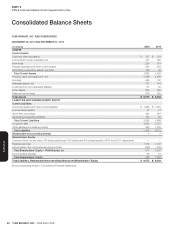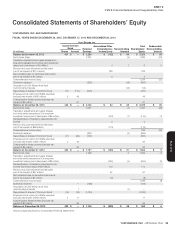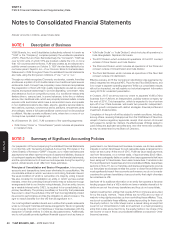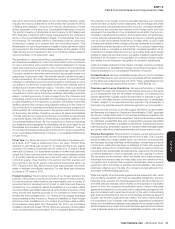Pizza Hut 2015 Annual Report Download - page 139
Download and view the complete annual report
Please find page 139 of the 2015 Pizza Hut annual report below. You can navigate through the pages in the report by either clicking on the pages listed below, or by using the keyword search tool below to find specific information within the annual report.
YUM! BRANDS, INC.-2015 Form10-K 31
Form 10-K
PART II
ITEM7Management’s Discussion and Analysis of Financial Condition and Results of Operations
During 2015, the Company’s reporting units with the most significant
refranchising activity and recorded goodwill were KFC India, Taco Bell
U.S. and KFC China. Within KFC India, 86 restaurants were refranchised
(representing 42% of beginning-of-year company units) and less than
$1million in goodwill was written off (representing 25% of beginning-of-year
goodwill). Within Taco Bell U.S., 65 restaurants were refranchised
(representing 7% of beginning-of-year company units) and $2 million in
goodwill was written off (representing 2% of beginning-of-year goodwill).
Within KFC China, 52 restaurants were refranchised (representing 1%
of beginning-of-year company units) and less than $1 million in goodwill
was written off (representing less than 1% of beginning-of-year goodwill).
See Note 2 for a further discussion of our policies regarding goodwill.
Self-Insured Property and Casualty Losses
We record our best estimate of the remaining cost to settle incurred
self-insured property and casualty losses. The estimate is based on the
results of an independent actuarial study and considers historical claim
frequency and severity as well as changes in factors such as our business
environment, benefit levels, medical costs and the regulatory environment
that could impact overall self-insurance costs. Additionally, our reserve
includes a risk margin to cover unforeseen events that may occur over
the several years required to settle claims, increasing our confidence level
that the recorded reserve is adequate.
See Note 18 for a further discussion of our insurance programs.
Pension Plans
Certain of our employees are covered under defined benefit pension
plans. Our two most significant plans are in the U.S. and combined had
a projected benefit obligation (“PBO”) of $1,134 million and a fair value of
plan assets of $1,004 million at December 26, 2015.
The PBO reflects the actuarial present value of all benefits earned to date
by employees and incorporates assumptions as to future compensation
levels. Due to the relatively long time frame over which benefits earned to
date are expected to be paid, our PBOs are highly sensitive to changes in
discount rates. For our U.S. plans, we measured our PBOs using a discount
rate of 4.90% at December 26, 2015. This discount rate was determined
with the assistance of our independent actuary. The primary basis for our
discount rate determination is a model that consists of a hypothetical
portfolio of ten or more corporate debt instruments rated Aa or higher by
Moody’s or S&P with cash flows that mirror our expected benefit payment
cash flows under the plans. We exclude from the model those corporate
debt instruments flagged by Moody’s or S&P for a potential downgrade
(if the potential downgrade would result in a rating below Aa by both Moody’s
and S&P) and bonds with yields that were two standard deviations or
more above the mean. In considering possible bond portfolios, the model
allows the bond cash flows for a particular year to exceed the expected
benefit payment cash flows for that year. Such excesses are assumed to
be reinvested at appropriate one-year forward rates and used to meet the
benefit payment cash flows in a future year. The weighted-average yield of
this hypothetical portfolio was used to arrive at an appropriate discount rate.
We also ensure that changes in the discount rate as compared to the prior
year are consistent with the overall change in prevailing market rates and
make adjustments as necessary. A 50 basis-point increase in this discount
rate would have decreased these U.S. plans’ PBOs by approximately
$70 million at our measurement date. Conversely, a 50 basis-point decrease in
this discount rate would have increased our U.S. plans’ PBOs by approximately
$80 million at our measurement date.
The pension expense we will record in 2016 is also impacted by the
discount rate, as well as the long-term rates of return on plan assets and
mortality assumptions we selected at our measurement date. We expect
pension expense for our U.S. plans to decrease approximately $35 million
in 2016. The decrease is primarily driven by a decrease in amortization
of net loss due to lower net unrecognized losses in Accumulated other
comprehensive income. Lower net unrecognized losses in Accumulated
other comprehensive income are primarily a result of a higher discount rate
at our 2015 measurement date. A 50 basis-point change in our discount
rate assumption at our measurement date would impact our 2016 U.S.
pension expense by approximately $6 million.
Our estimated long-term rate of return on U.S. plan assets is based upon
the weighted-average of historical returns for each asset category. Our
expected long-term rate of return on U.S. plan assets, for purposes of
determining 2016 pension expense, at December 26, 2015 was 6.75%.
We believe this rate is appropriate given the composition of our plan assets
and historical market returns thereon. A 100 basis point change in our
expected long-term rate of return on plan assets assumption would impact
our 2016 U.S. pension expense by approximately $10 million. Additionally,
every 100 basis point variation in actual return on plan assets versus our
expected return of 6.75% will impact our unrecognized pre-tax actuarial
net loss by approximately $10 million.
A decrease in discount rates over time has largely contributed to an
unrecognized pre-tax actuarial net loss of $138 million included in
Accumulated other comprehensive income (loss) for these U.S. plans at
December 26, 2015. We will recognize approximately $6 million of such
loss in net periodic benefit cost in 2016 versus $45 million recognized in
2015. See Note 13.
Income Taxes
At December 26, 2015, we had valuation allowances of approximately
$250 million to reduce our $1.2 billion of deferred tax assets to amounts
that are more likely than not to be realized. The net deferred tax assets
primarily relate to temporary differences in profitable U.S. federal, state and
foreign jurisdictions, net operating losses in certain foreign jurisdictions,
the majority of which do not expire, and U.S. foreign tax credit carryovers
that expire 10 years from inception and for which we anticipate having
foreign earnings to utilize. In evaluating our ability to recover our deferred
tax assets, we consider future taxable income in the various jurisdictions
as well as carryforward periods and restrictions on usage. The estimation
of future taxable income in these jurisdictions and our resulting ability
to utilize deferred tax assets can significantly change based on future
events, including our determinations as to feasibility of certain tax planning
strategies. Thus, recorded valuation allowances may be subject to material
future changes.
As a matter of course, we are regularly audited by federal, state and foreign
tax authorities. We recognize the benefit of positions taken or expected
to be taken in our tax returns in our Income Tax Provision when it is more
likely than not that the position would be sustained upon examination by
these tax authorities. A recognized tax position is then measured at the
largest amount of benefit that is greater than fifty percent likely of being
realized upon settlement. At December 26, 2015 we had $98 million of
unrecognized tax benefits, $89 million of which are temporary in nature
and, if recognized, would not impact the effective tax rate. We evaluate
unrecognized tax benefits, including interest thereon, on a quarterly basis to
ensure that they have been appropriately adjusted for events, including audit
settlements, which may impact our ultimate payment for such exposures.
We have investments in foreign subsidiaries where the carrying values for
financial reporting exceed the tax basis. We have not provided deferred
tax on the portion of the excess that we believe is indefinitely reinvested,
as we have the ability and intent to indefinitely postpone these basis
differences from reversing with a tax consequence. We estimate that our
total temporary difference upon which we have not provided deferred tax
is approximately $2.3 billion at December 26, 2015. A determination of
the deferred tax liability on this amount is not practicable.
If our intentions regarding our ability and intent to postpone these basis
differences from reversing with a tax consequence change, deferred tax
may need to be provided that could materially impact the provision for
income taxes.
See Note 16 for a further discussion of our income taxes.



